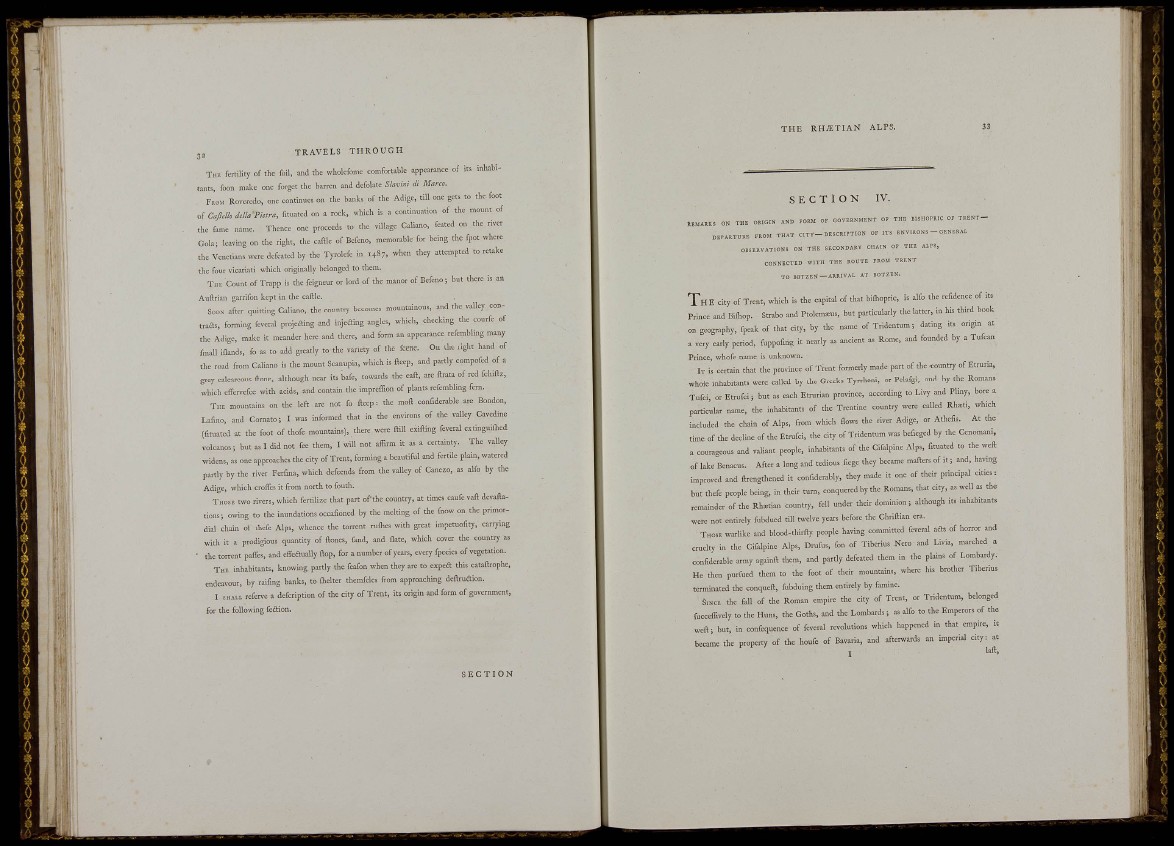
pi i I
f . . . , .
T i , , fertility of the foil, and tlic wliolefome eomfottable appeatancc of its iahabitants,
fooa malee one forget the Ijarrea and dcfolate SImmi di Mara.
FROM Rovctedo, one continues on tlie banks of the Adige, till one gets to the foot
of CJldh d.lla -pu.ra, fituated on a ,oek, which is a continuation of the moant of
the fame „ante. Thence one proceeds to the village Caliano, f.ated on the ri.er
Gola; leaving on the right, the caftle of Befeno, memorable for being the fpot where
the Venetians were defeated by the Tyrolefe in .+87, when they attempted to retake
the four vicariati which originally belonged to them.
T n . Count of Trapp is the feigneur or lord of the manor of Befeno; but there is an
Auilrian garrifon kept in the caille.
SOON after quitting Caliano, the conntr, bcc<„„CS mountainous, and the valley contrafls,
forming feveral projcfling and injeffing angles, which, cheeking the eoutfe of
the Adige, make it meander here and there, and form an appcarance refembling many
fmall idands, fo as to add greatly to-the variety of the feene. On the right hand of
the road from Caliano is the mount Seanupia, which is fteep. and partly eompofed of a
grey ealeareous Hone, although near its bafe, towards the eaft, are ft,ata of red fehift.,
which effervefee with acids, and contain the impreffion of plant, refembling fern.
TH> mountains on the left are not fo fteep: the moft confiderable are Bondoa,
Lafino, and Cornato; I was informed that in the environs of the valley Cavedine
(frtuated at the foot of thofe mountains), there were M l cxifting feveral c.tinguiflred
voléanos; but as I did not fee them, I will not affirm it a, a cctainty. The valley
widens, as one approaches the city of Trent, forming a beautiful and fertile plain, watered
partly by the river Ferfina, which defcends from the valley of Caneco, as alfo by the
Adige, which erofl'cs it from north to ibuth.
TnoiE two rivers, which fertilize that part ofthe country, at times caufe vaft dcvaftations;
owing to the inundation, occafioned by the melting of the fnow on the primordial
chain ot ihrfe Alp., whence the torrent rulhe. with great impetuofity,' carrying
with it a prodigious quantity of ftones, fand, and ftate, which cover the country as
• the torrent paflbs, and efTeflually ftop, for a number of years, every fpceies of vegetation.
THE inhabitants, knowing partly the feafon when they ate to eipefl this cataftrophe,
endeavour, by raiftng banks, to Ihelter thcmfcles from approaching defttudion.
I sHjLt referve a defcription of the city of Trent, its origin and form of government,
for the following fedlion.
T H E RH^TIAN ALPS.
S E C T I O isr IV.
t.MARI. 0» TH. ORIGIK a»D F0.« OF OOV«»»ME»T O. TH. .tSHOP.rC OF T.ENT-
»EPAETO.. «0M THAT e.TV-»!.C«.PT>OK OP .TS E»V..ON. - GEHE.«L
OBSERVATIONS ON THE SECO«nARY CHAIN OF THE AlPS,
CONNECTED WITH THE MUTE FROM TRENT
TO BÖTZEN —ARBtVAL AT BÖTZEN.
T H E city of Trent, which is the capital of that bilhopric, i. alfo the reSdenec of its
Prince and Biihop. Strabo and Ptolemxu., but particularly the latter, in his third book
on „ography, fpeak of that city, by the name of Tridentum; dating it. orrgm at
a very early period, fuppofing it nearly as ancient as Rome, and founded by a Tufean
Prince, whofe name is unknown.
IT i. certain that the province of Trent formerly made part of the counOy of Etruria,
whofe inhabitants were called by the Greeks Tyrrheni, or Pel.fgi, and by the Roman.
Tufei, or Etrufci; but as each Etrurian province, according to Livy and Pliny, bore a
particular name, the inhabitants of the Trcntine country were callcd Rha.ti, which
included the chain of Alps, from which flows the river Adige, or Athefrs. At the
time of the decline of the Etrufci, the city of Tridentum was befieged by the Cenoman,,
a courageous and valiant people, inhabitants of the Cifalpine Alps, frtuated ,0 the weft
of lake Benaeus. After a long and tedious fiege they bccame mafters of i t ; and, h.vmg
improved and ftrength.ned it eonf.derably, they made it one of their prine.pal ernes:
but thefe people being, in their turn, conquered by the Romans, that ctty, as well as the
remainder ofthe Rh«i . n country, fell under their dominion; although its inhabrtant.
were not entirely fubducd till twelve years before the Chriftian era.
THOSE warhke and blood-thhfty people having committed feveral afls of horror and
cruelty in the Cifalpine Alps, Drufus, fon of Tiberius Nero and Livia, marched a
confiderable army againft them, and partly defeated them in the plains of Lombardy.
He then parfued them to the foot of their mountains, where his brother Tiberms
termmated the conqueft, fubduing them entirely by famine.
S,NC. the fall of the Roman empire the city of Trent, or Tridentum, belonged
fucceffively to the Huns, the Goths, and the Lombard.; as alfo to the Emperors of the
weft; but, in confequcnce of feveral revolutions which happened in that empire, it
became the property of the houfe of Bavaria, aitd afterwards an imperial city: at
I laft,
M r i
•'M